Standard Cemented
Achromatic Doublets
Paralight Optics offers a variety of custom achromatic optics with customer-defined sizes, focal lengths, substrate materials, cement materials, and coatings are custom-made. Our achromatic lenses cover the 240 – 410 nm, 400 – 700 nm, 650 – 1050 nm, 1050 – 1620 nm, 3 – 5 µm, and 8 – 12 µm wavelength ranges. They are available unmounted, mounted or in matched pairs. Regarding unmounted achromatic doublets & triplets line-up, we can supply achromatic doublets, cylindrical achromatic doublets, achromatic doublet pairs that are optimized for finite conjugates and ideal for image relay and magnification systems, air-spaced achromatic doublets that are ideal for high-power applications due to a greater damage threshold than cemented achromats, as well as achromatic triplets that allow for maximum aberration control.
Paralight Optics’ cemented Achromatic Doublets are available with antireflection coatings for the visible region of 400 – 700 nm, extended visible region of 400 – 1100 nm, near IR region of 650 – 1050 nm, or IR range of 1050 – 1700 nm wavelength range. They are optimized to provide excellent performance in the visible and near-infrared (NIR) regions, the extended antireflection (AR) coating makes them ideal for fluorescence microscopy applications. Please check the following graph of coatings for your references. Achromatic doublets are used as telescope objectives, eye loupes, magnifying glasses and eyepieces. Achromatic doublets have also been used to focus and manipulate laser beams because their image quality is superior to single lenses.

Features:
Benefits:
Minimization of Chromatic Aberration & be Corrected for on-Axis Spherical Aberration
Optical Performance:
Achieving Smaller Focal Spots, Superior Off-Axis Performance (Lateral and transverse aberrations are greatly reduced)
Achromatic Options:
Custom Achromatic Optic Available
Applications:
Be Used to Focus and Manipulate Laser Beams, Ideal for Fluorescence Microscopy Applications

Common Specifications:

Reference Drawing for
achromatic doublet
f: Focal Length
fb: Back Focal Length
R: Radius of Curvature
tc: Center Thickness
te: Edge Thickness
H”: Back Principal Plane
Note: For best performance when collimating a point source, generally the first air-to-glass interface with the greater radius of curvature (flatter side) should face away from the refracted collimated beam, conversely when focusing a collimated beam, the air-to-glass interface with the shorter radius of curvature (the more curved side) should face the incident collimated beam.
Parameters
Ranges & Tolerances
-
Substrate Material
Crown and Flint Glass Types
-
Type
Cemented Achromatic Doublet
-
Diameter
6 - 25mm / 25.01 - 50mm / >50mm
-
Diameter Tolerance
Precison: +0.00/-0.10mm | High Precision: >50mm: +0.05/-0.10mm
-
Center Thickness Tolerance
+/-0.20 mm
-
Focal Length Tolerance
+/-2%
-
Surface Quality (scratch-dig)
40-20 / 40-20 / 60-40
-
Surface Irregularity (Peak to Valley)
λ/2, λ/2, 1 λ
-
Centration
< 3 arcmin / < 3 arcmin / 3-5 arcmin
-
Clear Aperture
≥ 90% of Diameter
-
Coating
1/4 wave MgF2 @ 550nm
-
Design Wavelengths
486.1 nm, 587.6 nm, or 656.3 nm

Graphs
The right- side graph shows Comparison of Reflectance Curves of AR-Coated Achromatic Doublets for the different wavelength ranges (Red for visible of 400 - 700nm, Blue for extended visible of 400-1 100nm, Green for near IR of 650 - 1050nm)
Focal Shift vs. Wavelength
Our achromatic doublets are optimized to provide a nearly constant focal length across a broad bandwidth. This is accomplished by utilizing a multi- element design in the Zemax⑧to minimize the chromatic aberration of the lens. Dispersion in the first positive crown glass of the doublet is corrected by the second negative flint class, resulting in better broadband performance than spherical singlets or aspheric lenses.
The graphs below show the paraxial focal shift as a function of wavelength for the three different achromatic doublet samples for your reference.

The paraxial focal shift as a function of wavelength for the achromatic doublet (400 mm focal length, Ø25.4 mm, AR coated for the 400 to 700 nm range)

The paraxial focal shift as a function of wavelength for the achromatic doublet (150 mm focal length, Ø25.4 mm, AR coated for the 400 to 1100 nm range)








